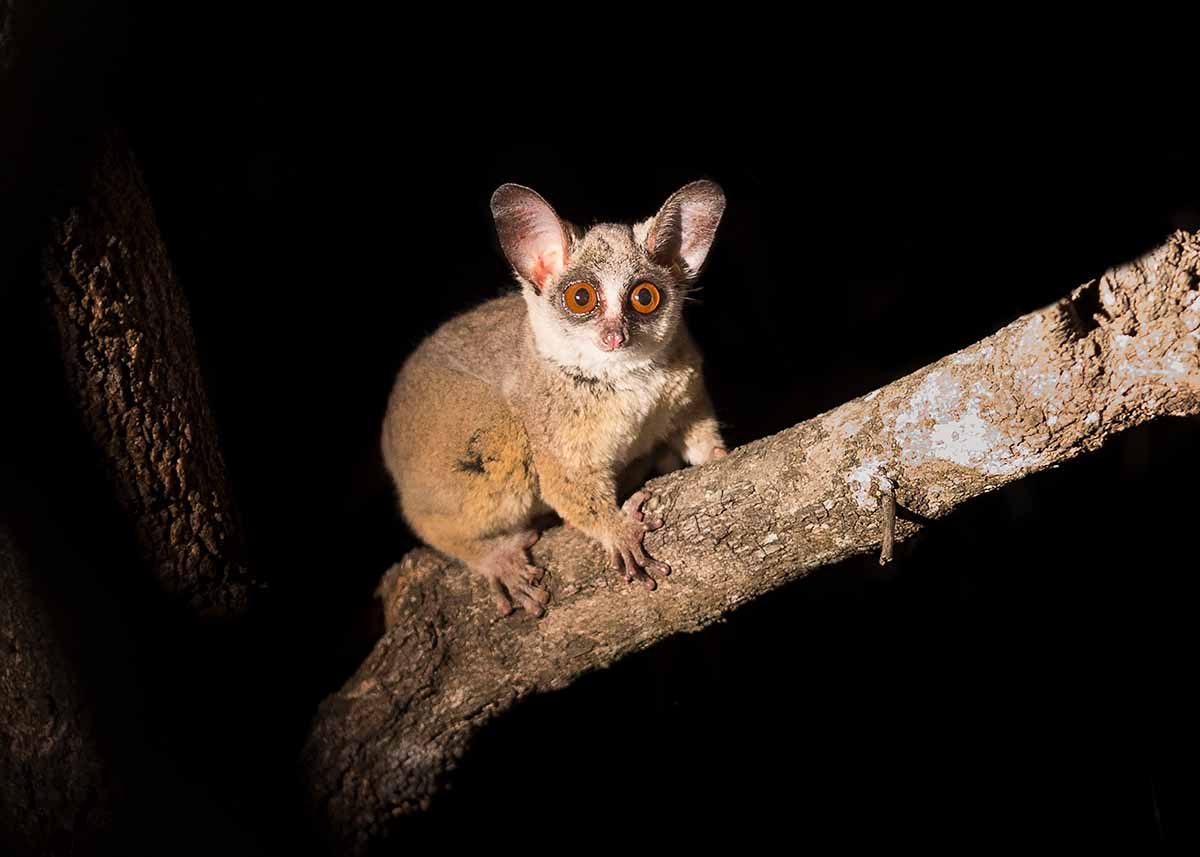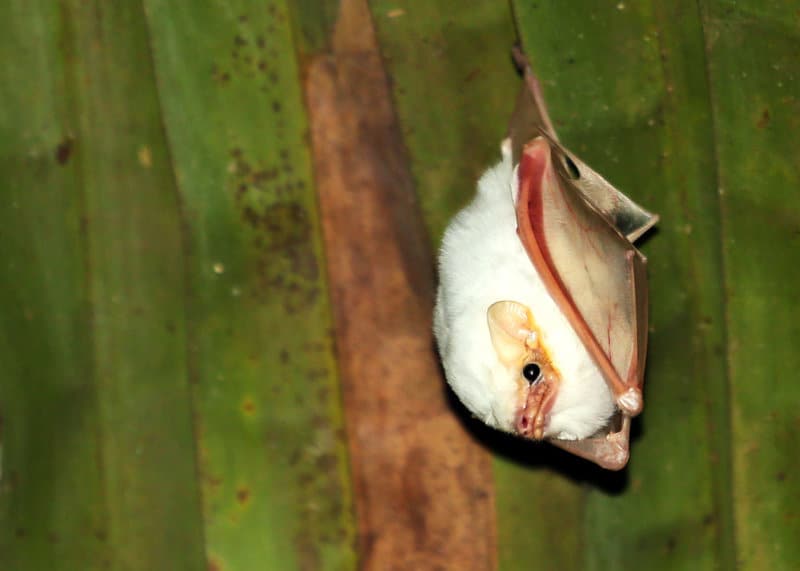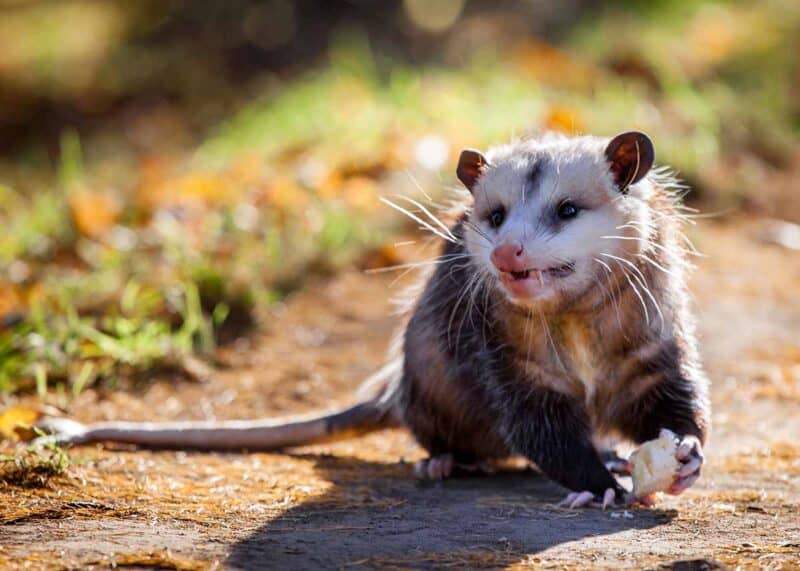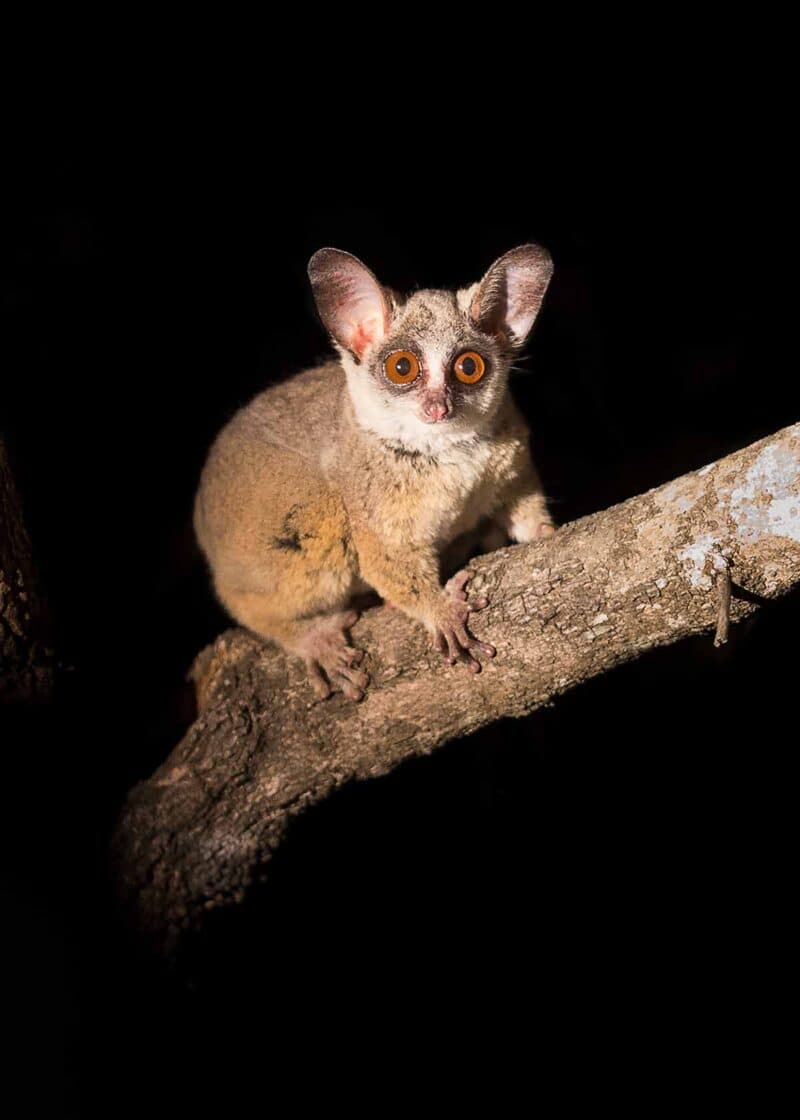Most living things can be categorized as either nocturnal or diurnal.
- Diurnal creatures are active during the day and sleep at night, like humans.
- Nocturnal creatures are the opposite – they sleep all day and are active at night.

Table of Contents
Nocturnal Animals List: 114
I’m working to build a complete list of nocturnal animals. Please let me know in the comments which ones I’ve missed. Following the list are details on 26 of my favorite nocturnal animals.
- Aardvark
- Aye-aye
- African elephant*
- American black bear
- Badger
- Ball Python
- Bandicoot
- Bat
- Bat-eared fox
- Beaver
- Bilby
- Binturong
- Black rhinoceros
- Black rat
- Black-footed cat
- Bobcat
- Brown rat
- Bushbaby (Galago)
- Bush rat
- Capybara*
- Caracal
- Cat*
- Catfish
- Cheetah
- Chinchilla
- Civet
- Cockroach
- Cougar
- Coyote
- Cricket
- Cacomistle
- Cyprus spiny mouse
- Dingo
- Dog (Can be active day or night)
- Dwarf crocodile
- Eastern woolly lemur
- Firefly
- Flying squirrel
- Gecko
- Genet
- Gerbil* (Some are diurnal)
- Giraffe*
- Gray wolf
- Great grey slug
- Great white shark*
- Hamster
- Hedgehog
- Hermit crab
- Hippopotamus
- Honey badger
- Hyena
- Hoffmann’s two-toed sloth
- Iranian jerboa
- Jaguar*
- Kangaroo*
- Kiwi
- Koala*
- Kinkajou
- Kit fox*
- Leopard
- Leopard Gecko
- Lion*
- Loris (Slender and Slow species)
- Lynx
- Margay
- Mink*
- Mole
- Mouse
- Nightingale
- Nightjar
- Nine-banded armadillo
- Octodon (But not the diurnal degus)
- Oncilla
- Ocelot
- Opossum
- Orca*
- Otter
- Owl
- Owl monkey
- Pacarana
- Panamanian night monkey
- Pangolin
- Platypus
- Paradoxical frog
- Polar bear
- Porcupine
- Possum
- Potoo
- Puma
- Python regius
- Quoll
- Rabbit rat
- Raccoon
- Red-eyed tree frog
- Red fox
- Ringtail
- Scorpion
- Skink
- Skunk
- Spectacled bear
- Sportive lemur
- Sugar glider
- Tapeti
- Tarantula
- Tarsier
- Tasmanian devil
- Tiger (Most subspecies)
- Onychophora
- Western woolly lemur
- Whip-poor-will
- White-faced storm petrel (When raising chicks)
- White-tailed deer*
- Wild boar
- Wombat
* Crepuscular (or some species in the category are) In some cases, they are thought to be somewhat crepuscular, but more research is needed.
What is Crepuscular? Relating to twilight. In zoology, crepuscular refers to animals active in twilight (dawn or dusk).
Nocturnal Animal Details: 26 Types
Here are details on some of the more notable nocturnal animals.
6 Nocturnal Mammals
There are a lot of nocturnal animals out there; let’s look at a few.
1. Bats
Not all bats are nocturnal, but these mammals are made to live in the dark.
They use echolocation to locate insects around them and hunt. They emit high-pitched sounds that we can’t hear at a rate of 10-20 beeps per second and listen to the echoes. They feast primarily on mosquitos, and they often eat their body weight in bugs every night.
They’re also the only mammals that fly. And they’re fast! Depending on the species, they can typically fly at speeds of 60 mph to 100 mph.
Learn more about Honduran white bats.

2. Opossums
You probably won’t run into an opossum during the day, but you may hear them scurrying around your yard at night. These nocturnal creatures sleep during the day and hunt for food at night.
They don’t do a full hibernation, but they do spend more time in their burrows during the winter, storing up fat to stay warm.
Opossums typically eat whatever they find in the trash, and they’re omnivores, so they’ll eat just about anything. Depending on where they are, they’re known to eat nuts, grass, fruit, bugs, small rodents, birds, snakes, worms, roadkill, or garbage.

Learn more about animals with pouches.
3. Raccoons
Raccoons have a reputation for rifling through backyard trash cans at night, which is common for nocturnal critters. Like opossums, raccoons hunt for food at night and are omnivores who will eat just about anything they can get their paws on.
They hunt for food at night because most of their main predators are asleep, so they don’t have quite as much to worry about. They’ll also find less competition on their hunt for food.
Did you know that raccoons hibernate? See more in our guide: 25 Animals that Hibernate in Winter.
4. Hedgehogs
These cute little pokey guys like to hide away and sleep in shaded garden areas during the day; then, they wake up in the evenings to explore when it’s safer.
Hedgehogs primarily eat bugs and vegetation in the wild.
5. Cats
So cats aren’t technically nocturnal, though many people assume they are. They’re actually crepuscular, which means they’re most active at dusk and dawn.
They’re often awake during hours that we would normally sleep, which leads many cat owners to believe their pets are nocturnal.
Cats typically nap 12 to 15 hours daily, though they’re very alert during their naps.
More reading: Animals that Eat Grass
6. Aardvarks
Aardvarks burrow into the ground during the day to escape the hot African sun.
They use their claws to dig holes up to two feet deep, and they sleep there until the sun goes down, and they can go catch bugs with their long tongues.
5 Nocturnal Reptiles
1. Ball Python
One thing to consider when buying a ball python is that it’ll likely be asleep while you’re awake. During the day, you’re more likely to find them curled up asleep in the darkest part of their enclosure they can find.
Ball pythons have pretty bad eyesight because their eyes are susceptible to UV lighting. That’s why they prefer to hunt in the dark – that, and the fact that most of their prey is likely asleep and easier to catch.
2. Skink
Not all skinks are nocturnal. Some species are diurnal, while others are nocturnal. The species found in Central America and South America are often seen foraging around for food during the day.
But the nocturnal species, Egernia and Eremiascincus, hide away in dark cracks and crevices during the day. If there’s one on your property, you’ll most likely find it hidden away in the garden, garage, attic, or basement during the day.
3. Geckos
As with the skinks, not all geckos are nocturnal, though most gecko species are. They are a common pet, but it’s worth noting that your little lizard friend probably won’t be awake much at the same time as you. They sleep up to 12 hours a day!
Many types of geckos don’t have eyelids, so their eyes don’t always look closed when sleeping.
There used to be a gecko that lived on our patio in Ecuador. Every night, it would come out and hunt insects in the light of our kitchen.
4. Boa Constrictors
Boa constrictors are nocturnal, so they’re not active during the day, but they don’t like to be cold so they may lay out and bask in the sun during the day if it gets too cold at night.
Like the ball pythons, boa constrictors can hunt at night while their prey is sleeping and unsuspecting.
5. Rattlesnakes
Rattlesnakes typically live in the desert, so they often prefer to be active at night when it’s not so hot. This also allows them to avoid their predators and catch their prey off-guard.
3 Nocturnal Amphibians
1. Green Tree Frog
Green tree frogs are more active at night, largely because the humidity is higher at nighttime. Hunting for food in the dark also helps them to avoid predators.
Tree frogs have incredible night vision and can even see spectrums of light that humans can’t see with the naked eye, which allows them to see color at night.
Learn more about animals that live in trees.
2. Pacman Frog
These round little frogs with their big, wide mouths look a lot like Pacman, hence their name. And like Pacman on his black board, they thrive in the darkness. They sit quietly and go unnoticed by prey until it’s too late – they leap forward with their large mouths and swallow their prey whole.
Like tree frogs, the pacman frog thrives in a humid environment. If it’s too dry, they’ll dig a little hole and hide in the soil until the air gets some moisture.
3. Sirens
Sirens are a weird species. They are long and slender like snakes but have two tiny front legs. They’re technically considered a type of salamander.
These unique little critters live in slow-moving shallow water and hide under weeds and vegetation during the day. When they come out at night, they eat invertebrates and plants.
4 Nocturnal Birds
Interested in just birds? See my list of nocturnal birds.
1. Owls
Owls are one of the more commonly known nocturnal animals. With their giant eyes and stellar hearing, they can track prey and swoop quietly to grab them. They typically sleep during the day.
2. Kiwis
These funny little New Zealand natives are nocturnal. They’re shy and not often seen in the wild.
Kiwis have long, skinny beaks that allow them to dig into the soil for invertebrates. Their nocturnal nature is helpful for this, as the bugs they like to munch on typically move closer to the surface overnight. This also helps protect them from predators.
Kiwis have an exceptional sense of smell.
3. Nightingales
Nightingales are pretty little brown birds that got their name because they belt out their loud songs overnight.
But they don’t typically sing year-round; the males sing during the breeding season of late spring and early summer to attract mates.
4. Nightjar
These birds were also named after the noises they make after the sun goes down – the night jar is described as making a jarring noise.
They are medium-sized birds who use the natural coloring of their feathers to hide during the day before going out at night.
4 Nocturnal Fish
1. Catfish
They aren’t all night-dwellers, but some species of catfish are nocturnal.
This isn’t the only thing that varies by catfish breed – some like stagnant water, while others prefer a current. Some catfish like saltwater, while others like freshwater.
2. Moray Eels
These eels have poor eyesight, so they do well at night. They have large nostrils that provide a stellar sense of smell, which helps them navigate around.
Moray eels are very colorful and smooth, with fins like a fish. They also have two jaws full of scary-looking teeth to help them attack their prey.
3. Snappers
Most snappers are nocturnal, so fishermen typically target them on night fishing trips. They like to hide during the day, so you’ll often find them near reefs or shipwrecks.
They come out at night and are named after their rows of sharp teeth that they can snap shut quickly when hunting or feeling threatened.
4. Octopus
Octopus are primarily nocturnal, though some of the ones kept in captivity at aquariums will wake up and be active during feeding time.
But in the wild, they hide away and camouflage themselves during the day to avoid predators. Octopuses are incredibly smart and flexible, so they can fit into just about any space to avoid capture.
4 Nocturnal Insects, Arachnids, and Mollusks
1. Cockroaches
Nobody wants a cockroach in their house, but there’s a good chance you won’t even know one is wandering around there.
Cockroaches tend to come out at night to hunt for food, and they find their way inside through any cracks or holes in the walls or under the doors. They’ll fit through openings you didn’t even know existed and hide in dark crevices until nightfall.
2. Crickets
When a cricket gets inside, it almost feels personal – they seem to only play their song when you’re trying to sleep.
Crickets are nocturnal, so they’re more active at night. And they like to hide in the dark, which makes them very hard to catch.
3. Fireflies
Fireflies are nocturnal, and it’s a good thing too! We wouldn’t be able to appreciate their captivating glow if they slept all night. Their light is caused by a chemical reaction in their lower abdomen that produces bioluminescence.
Instead, they hide away and sleep during the day and delight families with their twinkling light show at night. Fireflies’ glow is used for mating and hunting.
4. Scorpions
If you live in the desert, you’ve probably learned to avoid scorpions and their stingers. But luckily, they’re mostly nocturnal and tend to hide away in dark cracks or crevices during the day.
Just keep an eye out if you’re walking around at night since that’s when they typically emerge to hunt for food.

4 Facts About Nocturnal Animals
- About 65 percent of the world’s mammal population is nocturnal.
- Owls are great nighttime hunters. They have super-strong night vision and exceptional hearing that allows them to hunt even the tiniest of prey in the dark of the night.
- But not all nocturnal animals have good night vision, some rely on other heightened smells to get around at night, like smell or hearing or taste.
- Bats use echolocation to hunt and navigate at night. They make high-pitched sounds that we can’t even hear, and they listen for echoes from the things around them.
Your Turn
What is your favorite nocturnal animal? Did I miss one? Let me know in the comments so I can add it!
Drew Haines is an animal enthusiast and travel writer. She loves to share her passion through her writing.
She graduated high school at sixteen and started her own business, Everywhere Wild Media. And she runs Everywhere Wild and JustBirding. She also guest blogs on Storyteller.Travel
She lived in Ecuador for 6 years and explored the Galapagos Islands. Currently based in N.S., Canada.
